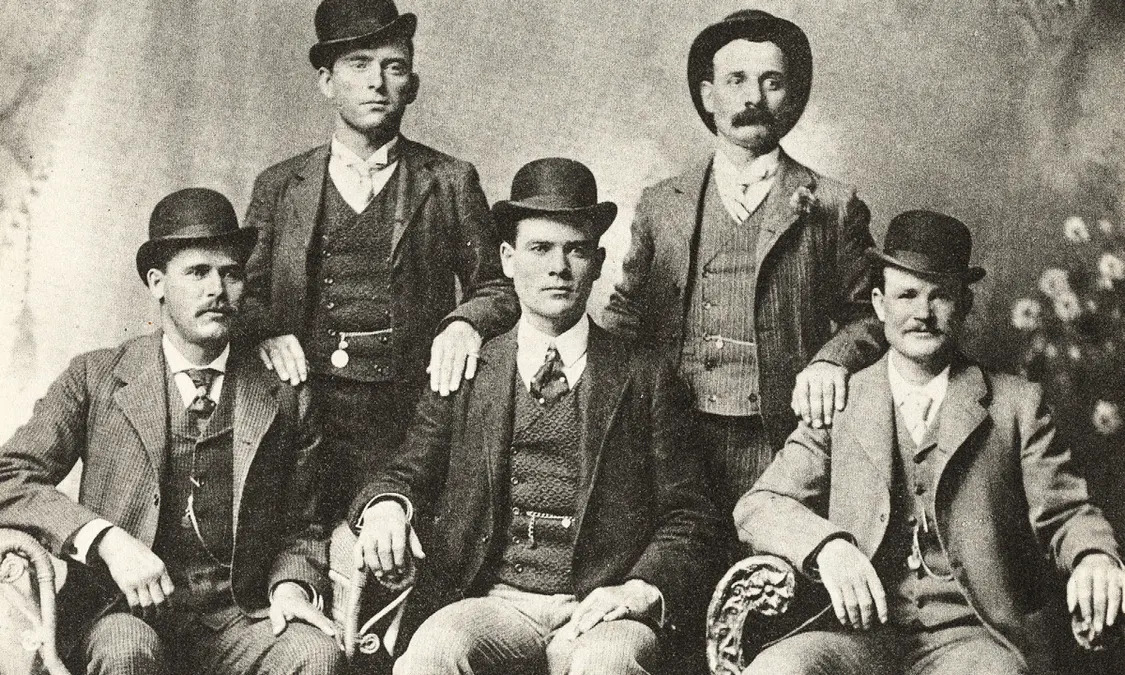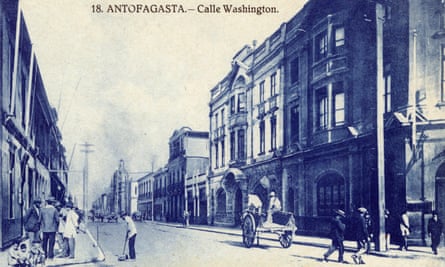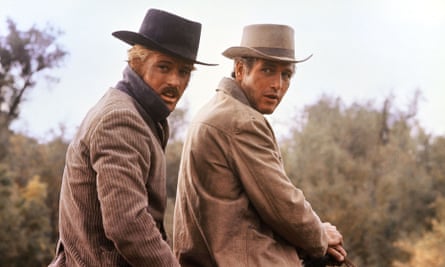Killing of officer in Chilean town of Antofagasta set in motion events that led to pair’s death in shootout with Bolivian soldiers.
 The Wild Bunch gang of American outlaws pictured in 1901. Butch Cassidy is seated on the right and Sundance seated on the left. Photograph: UniversalImagesGroup/Getty Images
The Wild Bunch gang of American outlaws pictured in 1901. Butch Cassidy is seated on the right and Sundance seated on the left. Photograph: UniversalImagesGroup/Getty Images
–
The two outlaws spent their nights carousing in the bordellos of a far west mining town where they were holed up, on the run from the law. One night, one of the fugitives got into a brawl at an after-hours restaurant. Lawmen arrived and ordered everyone into the street, but the drunken bandit drew his gun. He fired a single shot; an officer died.
The 1905 scene did not play out in the US, but in the Chilean port of Antofagasta – a boom town that at the time was as wild as any in the old American west – and it was detailed in a judicial report recently rediscovered in the country’s national archives.
The protagonists were the notorious US outlaws Butch Cassidy and the Sundance Kid, and the dog-eared file has revealed a previously unreported incident in their flight to South America, later immortalised in the eponymous 1969 film.
“It’s an unknown chapter in their life,” said Anne Meadows, who discovered the file with her husband Dan Buck. The couple have spent decades trailing the pair’s escape to South America, a search that has continued even after the 1994 publication of their book Digging Up Butch and Sundance. The couple have returned to South America 15 times, visiting the outlaws’ every known hiding place in Argentina, Chile and Bolivia in search of clues.
But the newly discovered document – which Meadows and Buck found this June – proves not only that Sundance, whose real name was Harry Alonzo Longabaugh, killed a police officer in Chile but also that he was helped to escape by a US diplomat.
“It happened in this period between Argentina and Bolivia when no one really knows what they were up to,” said Meadows, speaking by telephone from their home in Washington. “Sundance had been in the bordellos of Antofagasta that evening, and several other evenings, with Butch Cassidy,” added Buck.
The wild west outlaws had escaped to Argentina in 1901 after a series of brazen train robberies in the US had put the renowned Pinkerton Detective Agency on their tail. With Sundance’s lover Etta Place, they boarded the British ship Herminius to Buenos Aires.
–
They settled in a small cabin in Cholila, a tiny town in southern Argentina, enjoying an idyllic existence until mid-1905, when the Argentinian police were alerted by Pinkerton and began to hunt them down. Sundance accompanied his wife in a ship back to the US, then returned alone to join Cassidy, who had gone into hiding in Chile. In Argentina, he had called himself Harry Place, but once he crossed the border, he went back to the pseudonym he had once used in the US: Frank Boyd.
Sundance’s rash act in Antofagasta set in motion the series of events that led, three years later, to their death in a shootout with a Bolivian army unit, fictionalised in the film’s famous last scene in which Paul Newman and Robert Redford are freeze-framed as they charge, guns blazing, into a hail of gunfire.
The Chilean document relates the events of 1905 Aug 21 in microscopic detail. “Depending on whose version you believe, Sundance either shot his gun or it went off accidentally,” said Buck. “Butch Cassidy didn’t find out about it till later in the morning,” added Meadows.
Cassidy enlisted Frank Aller, the US vice-consul in Antofagasta, who signed a bond, equivalent to $50,000 today, for the release of Frank Boyd. “Aller even provided a house for Sundance’s house arrest,” said Meadows.
The killing was reported in the pages of the Antofagasta daily El Industrial. “A decently dressed man, of Yankee nationality, who in his manners and in everything purported to be a gentleman of good standing” shot the officer at close range, “killing him instantly,” the newspaper reported.
–
Sundance was arrested at his hotel trying to hire a carriage to leave the city. He had nearly $70,000 in cash, a firearm and munitions, as described in an article by Meadows and Buck published in this month’s journal of the Wild West History Association.
The 24-year-old officer, Arturo González, was buried the next day with full honors, including a procession, marching band and a flower-draped hearse followed by his young widow and two-year-old son.
–
Boyd’s shot was “fixed and calculated … he must be well versed in handling a revolver,” said witnesses. Boyd alleged that “the shot was fired by chance, which happens so many times and very easily with the Smith & Wesson revolver without an open trigger, which I carried”.
Butch testified in Sundance’s favor under the alias Thomas Fisher. “I am Frank Boyd’s partner, and we have come from the United States to study the cattle business,” he said.
Sundance was eventually released into the care of the US vice-consul. Predictably, Sundance fled, leaving Aller responsible for paying the $50,000 bond. It is not clear if he ever did. “We think Cassidy may have advanced Aller the money,” said Meadows.
The pair headed back to Argentina, got in trouble again for a bank heist there, and then fled north to Bolivia, where they faced their last stand in November 1908.
Meadows and Buck had given up on ever finding the missing pieces of the puzzle. But unbeknown to them, copies of the old El Industrial newspaper had been digitised in Chile.
A fluke online search by Buck turned up a host of articles about the Frank Boyd case, which led the couple to the revealing judicial file. “It arrived out of nowhere, and serendipitously,” said Buck.
The film that created a legend … and became a legend
In 1969, Butch Cassidy and the Sundance Kid made Hollywood history – and remade American history. This sublimely seductive western thriller took the already stellar careers of Paul Newman and Robert Redford to new levels; their impossible handsomeness and cool wit made them almost godlike.
The film also took the then little-known 19th-century bank robbers Robert Leroy Parker (aka Butch Cassidy) and Harry Longbaugh (aka the Sundance Kid) of the murderous Wild Bunch and reshaped their lives, reinventing them as groovy countercultural outlaws, not so different from Dennis Hopper and Peter Fonda in Easy Rider. And imagining these guys’ escape to South America in the company of Sundance’s girlfriend, played by Katharine Ross, made them jazzily bohemian and à trois in the French style, like Truffaut’s Jules Et Jim or Godard’s Bande à Part – although the sexist treatment of Ross’s character jars a bit now.
Newman’s goofy clowning around on a bike to the tune of Burt Bacharach’s Raindrops Keep Falling on My Head is tremendous, although with anyone less charismatic it would just be cloying. And Redford’s laconic delivery is a joy: “Think you used enough dynamite there, Butch?” says Sundance when the entire train carriage explodes.
Basically, Butch and Sundance invented the “buddy comedy” in Hollywood cinema which morphed into the bromance of recent times. And the Sundance Kid, that tough American icon, in effect lent his stonewashed American authenticity and ruggedness to the films that keep coming out of Redford’s Sundance film festival.
The film created a legend, and it’s a legend itself. Peter Bradshaw
–
Topics















